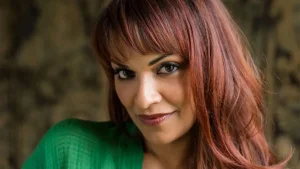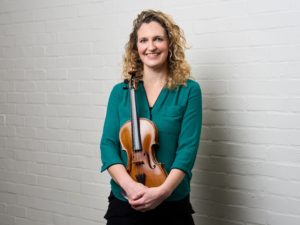
Mozart, master of drama: LMP with Danielle De Niese

Mozart, master of drama: LMP with Danielle De Niese
While in Prague in early 1787, attending and conducting performances of his most recently completed opera Le nozze di Figaro and concerts of several of his instrumental works, Mozart received a commission from Prague impresario Pasquale Bondini for a new opera, which was to be produced in Prague during October 1787. Mozart returned to Vienna and asked Lorenzo Da Ponte, the librettist for Figaro, for another opera libretto. Don Giovanni became the second of three so-called opera buffa that Mozart would compose to a libretto by Da Ponte, the third of which, Così fan tutte, he would complete in early 1790. However, the opera is neither opera buffa nor opera seria, and so is known as dramma giocoso.
Da Ponte’s libretto shows the influence of Bertati’s libretto for Gazzaniga’s opera Convitato di pietra. The première of Don Giovanni took place to great public and critical acclaim in Prague on 29 October 1787. The Prague reception of Don Giovanni was more positive than that of the opera’s first Vienna performances in 1788, for which reviews suggested mild dissatisfaction with the work’s extended length and unnecessary plot elaborations.
Although the opera itself was completed before the première, the overture remained incomplete until the last moment. Legend has it that the night before the performance (or dress rehearsal) Mozart attended a party. On returning home, his wife kept him awake throughout the night with stories as he wrote down the notes to the overture, finally providing the score to copyists at 7 o‘clock the next morning. As Mozart’s compositional method most often involved completing a work in his head and then writing it down, and as he was a known procrastinator, the veracity of this story is quite believable.
Don Giovanni develops the legend of the rakish nobleman, Don Juan, his sidekick Leporello, the Don’s various conquests and other characters that weave in and out of the plot. The opening of the overture gives a premonition of Don Giovanni’s final fate. The ominous treading of the stone statue from the last scene of the opera is heard in the sombre opening section. What follows is nothing less than a magnificent mini-symphonic movement. The various musical motives create an ambivalent atmosphere directly related to the opera’s conflicted characters and themes. The original opera version of the overture leads directly into the action of Act I, but the concert version, with its concert ending, has understandably proved to be an immensely popular and fulfilling experience.
© Elizabeth Boulton
Donna Elvira, who sings this aria, makes her first appearance in Don Giovanni singing another aria (“Ah, chi mi dice mai”) that describes her abandonment by a former lover, and her desire for revenge against him. She soon runs into Don Giovanni, recognizes him as the former lover, and spends the rest of the first act thwarting Don Giovanni’s subsequent attempts at seduction and warning others of his treachery. Yet in the first scene of the second act, Don Giovanni sings to Donna Elvira of his repentance and his desire to return to her. Donna Elvira is somehow convinced, but before she can come down from her room to meet Don Giovanni, he exchanges clothes with his servant, Loporello, so that Donna Elvira ends up following the servant. Soon enough, four of Don Giovani’s many enemies find Loporello, Donna Elvira attempts to protect him, and in order to save himself, Loporello reveals himself not to be Don Giovanni after all. Donna Elvira is once again furious at Don Giovanni’s perfidy, but at the same time she feels some pity for him, sensing that his numerous misdeeds will lead to his demise. It is this aria that expresses these conflicted feelings. “Mi tradì” was not heard at the premiere of Don Giovanni in Prague, but was added for subsequent performances in Vienna at the request of the original singer of Elvira’s part, Caterina Cavalieri, who wanted something with which to show off her impressive voice. Mozart obliged and wrote this coloratura aria (one containing elaborate and virtuosic ornamentation, heard here in frequent arpeggios, scales, and large leaps) both to please Cavalieri and to show the intensity of Elvira’s emotions at her second betrayal.
© Samuel Mazzarella
Mozart’s opera Le Nozze di Figaro, first performed on 1 May 1786, was a tremendous success. Most arias had to be repeated, and the final applause was overwhelming. Nevertheless, the opera was withdrawn after the ninth performance in December 1786. Cosa Rara’by Martin y Soler, of which an excerpt is played by the wind octet at Don Giovanni’s supper, had proved more popular than Figaro because the opera made less demands on the performers and, above all, on the audience.
Figaro was revived in 1789. Nancy Storace, the original Susanna, was replaced by Adriana Ferrarese del Bene, a friend of the librettist da Ponte. Susanna’s exquisite Deh, vieni was not spectacular enough for the new singer, and Mozart agreed to write a new work for her (a note in the printed score wrongly attributes this aria to the Countess). Al desiodi chi t’adora, written in July 1789, followed the recitative which preceded Susanna’s discarded Deh vieni and made no sense at all. But a Primadonna, as Mozart knew has to be satisfied, and the majority of the audience was, in any case, more interested in the star singers than in the dramatic logic of the opera. Mozart scored the new aria for bassoons, horns, strings and two basset horns. The latter did not appear anywhere else in Figaro, but their parts were presumably taken over by the clarinet players.
The aria begins with a larghetto in which the soprano calls for the return of her lover, recalling his former promises. In the following allegro she expresses her inability to resist the ‘burning ardour’ of love and asks those who have had similar experiences to commiserate with her.
© Stefan de Haan
Two days after Mozart’s twenty-fifth birthday, on 29th January 1781, Idomeneo was first performed in Munich. The opera had been commissioned by the Duke Elector Karl Theodor who had moved to Munich together with his court and the then famous Mannheim Orchestra. Mozart received the commission about four months before the first performance and set to work at great speed. The tragic story of Idomeneo, King of Crete, who had vowed to sacrifice the first person he met if he returned home safely and found that it was his son Idamante, had already been used in 1712 as the plot for an opera by Campra. It was adapted by Varesco to suit the requirements of the late eighteenth century: the original five acts were reduced to three and the intensity of the dramatic tension was increased.
When Mozart came to Munich in November 1780 to supervise the rehearsals and complete the opera he knew that he could count on the co-operation of his many friends involved in the staging of the work, among them, above all, the distinguished wind players of the orchestra. He knew them well from his visits to Mannheim, and their musicianship and virtuosity influenced his scoring considerably. It is curious that none of the contemporary reports say much about the music, particularly since the Duke Elector had shown his satisfaction by saying: “I was quite surprised. No other music has had this effect on me. It is magnificent music – hard to imagine that such great music could come from such a little man!”
The Ballet Music was probably written last, at any rate not before January 1781. It consists of two movements, each with variations, mainly for the solo dancers of the Munich opera whose names appear in the original score. These names are mostly French, and so is the form of the dances, while the idiom is truly Mozartian. The two movements are Chaconne and Pas seul (Largo)-Allegro.
© Stefan de Haan
Mozart composed the opera Il re pastore in 1775. An opera seria commissioned for a visit of Archduke Maximilian Francis of Austria, the youngest son of Empress Maria Theresa, to Salzburg, it was premiered on April 23 at the Palace of the Archbishop Count Heironymus von Colloredo. The libretto of the opera, by Metastasio, was written in 1751 and had already been set by the Italian composer Felice Giardini as a three-act opera. Mozart’s two-act version has only a few major changes from Metastasio’s original libretto.
Aminta, a shepherd and unknowingly the rightful heir to Sidon, professes his love for Elisa and that the ongoing war between the tyrant Stratone and King Alessandro of Macedonia will not affect their love. Once Stratone is disposed, King Alessandro begins searching for the rightful heir to the throne. While Elisa receives permission from her father to marry Aminta, Aminta learns that he is the rightful heir from Agenore, an aristocrat. Alessandro tells Aminta that when he becomes king, his royal duties come before love and, despite his love for Elisa, Alessandro advises him to he marry Stratone’s daughter, Tamiri, in order to ascend the throne. Everyone but Alessandro is distraught by the planned marriage. Tamiri confronts Alessandro stating she loves Agenore and she and Elisa both place themselves at his mercy. Realizing that he was about to separate two pairs of lovers, Alessandro tells Aminta to marry Elisa and Agenore to marry Tamiri. At the conclusion, Aminta is crowned king.
“L’amerò sarò costante,” from Act II, is one of the opera’s notable arias and is sung by Aminta when Elisa pleads with Alessandro to let her marry Aminta. Cast as a duet between Aminta (a castrato part) and a solo violin, the aria opens with a short introduction for the orchestra and solo violin. The violin never intrudes upon the vocal line and contents itself with filling in the spaces between the vocalist’s phrases. In triple time and an Andantino tempo, the aria is a beautiful affirmation of devotion to a loved one.
© Joseph DuBose
The opera La Clemenza di Tito was commissioned for 6th September 1791, the day when the Austrian Emperor was crowned King of Bohemia in Prague. The libretto of this opera seria in the old style was based on a text by the then famous poet Metastasio and written by Caterino Mazzolà. Mozart had barely a month to compose the music and was unable to identify himself with the subject or discuss it with the librettist. These circumstances and his deteriorating health (he died three months after the first performance of the opera) prevented him from being as much involved in the composition of this work as he had been in that of the slightly earlier Magic Flute. The subject of clemency was indeed close to his heart but not the sumptuous presentation of it which the occasion and the libretto demanded. Nevertheless, Mozart composed a number of remarkable scenes for ‘Tito’, among them the aria ‘Parto, parto’.
This Passionate composition is, in fact, a duet between the voice and the clarinet. The instrumental part was probably played at the first performance by Anton Stadler for whom Mozart also wrote his Clarinet Concerto. Stadler’s instrument had an extension which enabled him to play low notes beyond the range of the ordinary clarinet. These notes had to be transposed for the conventional instrument but the virtuosity required for the clarinet part, which rivals with that of the voice, is not affected by these slight alterations.
© Anon.
I Molto Allegro
II Andante
III Menuetto: Allegretto
IV Finale: Allegro assai
By the summer of 1788, Mozart was no longer a novelty in Vienna. After seven years of living there, he still had no court appointment commensurate with his needs and abilities, and money was increasingly difficult to find. It was under these strained circumstances that Mozart composed the three symphonies that would define the shape of the symphonic form for the next century: No. 39 on June 26, No. 40 on July 25 and No. 41 (Jupiter) on August 10.
Entire books, hundreds of book chapters and articles, and thousands of programme notes have been written about these symphonies. Symphony No. 40 has long been considered a manifestation of Mozart’s most personal voice, full of passion and seriousness. The symphony’s characteristic richness is accented by Mozart’s ingenious use of two horns pitched in two different keys, both of them high. This doubled the normal number of notes possible in his time on the limited scale of the horn, enabling the horns to contribute to the harmony instead of being silent.
The symphony opens with an intensely restless and dramatic theme on the strings, which leads to a gentler second theme, shared with the wind. The central development traces the opening figure through various keys, introducing a strongly contrapuntal element. The recapitulation is reached through a descending woodwind sequence, with the second theme now assuming particular poignancy in the minor key.
The Andante, in E flat, opens contrapuntally with successive entries. Despite the major key, an elegant pathos is created by the dissonance and the persistent underpinning of rhythmic repeated notes. The Minuet contains yet more counterpoint, with an accumulation of voices that sound adversarial, with rhythms askew in a rather dark setting. The tranquility of the Trio is shattered by the return of the Minuet.
The Finale’s opening, ‘Mannheim rocket’ (an ascending arpeggio figure), reverses the usual loud–soft dynamics by answering quiet with force. The movement’s already tenuous sense of tonality is shaken even further when it modulates from G minor to C sharp minor – the most distant key.
As many commentators have noted, this work is without peer in its clarity and balance. It is emotionally charged but never stormy. The relentless rhythm propels, but does not force, the flow. Daring harmonies make an appearance, but, within its classical framework, Mozart gently leads the way to the overt musical emotional expressions to come in the next century.
© Elizabeth Boulton
Violin 1
Ruth Rogers
Sijie Chen
Jessica Coleman
Nicoline Kraamwinkel
Anna de Bruin
Nemanja Ljubinkovic
Violin 2
Antonia Kesel
Gemma Sharples
Elise Scheurer
Clare Hayes
Felix Pascoe
Viola
Ian Rathbone
Christopher Beckett
Richard Cookson
Rebecca Low
Cello
Kate Gould
Sarah Butcher
Ben Chappell
Double Bass
Catherine Elliott
Phoebe Clarke
Flute
Harry Winstanley
David Cuthbert
Oboe
Gareth Hulse
Katie Clemmow
ACTING CHIEF EXECUTIVE (Projects Director)
Sophie Haynes
CONCERTS
Orchestra Manager & Fixer Jason Weir
Artistic Projects Coordinator Alex Mackinder
DEVELOPMENT
Development Director Tristen Hennigs
Fundraising & Operations Peter Wright
Fundraising Consultant Paul Hudson
Outreach & Evaluation Consultant Bec Britain
Honorary Chair – Friends of LMP Christine Robson
MARKETING
Senior Marketing & PR Manager Anna Bennett
Marketing and Development Coordinator Bethany Penny
Digital Marketing Manager Charles Lewis
EVENTS
Royal Event Manager Rachel Rae
Freelance Events Producer Sophie Branscombe
FINANCE
Bookkeeper Debbie Charles
Leader Debbie Beckerman & Keith Jones
Leader Sophie and Jeffrey Prett
Co-Leader Michael Southwell
Violin 1.3 Liz and Alistair Milliken
Violin 1.4 Gill Cox
Violin 1.5 Christine Robson
Violin 1.6 Della Brotherston
Violin 1.7 currently not sponsored
Violin 1.8 currently not sponsored
Violin 1.9 currently not sponsored
Associate First Violin currently not sponsored
Principal Second Violin Barbara Maw
Violin 2.2 The Angel Family
Violin 2.3 Mia and Keith Ball
Violin 2.4 Alastair Fraser
Violin 2.5 currently not sponsored
Violin 2.6 Catherine Shaw – Allbone and Trimit
Associate Second Violin currently not sponsored
Principal Viola Mark and Vanessa Petterson
Co-Principal Viola Stanley Slaughter & Linda Davidson
Viola 3 currently not sponsored
Viola 4 currently not sponsored
Associate Viola currently not sponsored
Principal Cello Anonymous
Sub-Principal Cello Leslie Aarons
Cello 3 Gillian Noble
Cello 4 currently not sponsored
Associate Cello Colin and Helen Snart
Associate Cello
Principal Double Bass John Clarke
Co-Principal Double Bass The Bristow Family
Principal Flute currently not sponsored
Sub-Principal Flute Raymond Calcraft
Principal Oboe Pat Sandry
Co-Principal Oboe currently not sponsored
Sub-Principal Oboe currently not sponsored
Principal Clarinet Deirdre Lea
Sub-Principal Clarinet Graham Harman
Principal Bassoon currently not sponsored
Sub Principal-Bassoon Barbara Tower
Principal Horn currently not sponsored
Sub-Principal Horn Chris Harman
Principal Trumpet Ishani Bhoola
Sub-Principal Trumpet Cynthia Harrod-Eagles
Principal Trombone currently not sponsored
Sub-Principal Trombone currently not sponsored
Principal Bass Trombone currently not sponsored
Principal Timpani Cynthia Harrod-Eagles
Principal Percussion currently not sponsored
LMP Play Bach’s Brandenburgs
Friday 17 October 2025
St. Martin-In-The-Fields
Bach’s most flashy and daring music like never before as St Martin’s is transformed into a cosmic experience with bespoke, live projections filling the walls as the orchestra plays.
Danielle De Niese
soprano

Last season, De Niese made her debut as Alice Ford in Verdi’s Falstaff with Hamburg State Opera. On the concert platform, De Niese performed Weill’s Seven Deadly Sins with the New World Symphony, a double bill of Purcell’s Dido and Aeneas and Seven Deadly Sins with the Danish National Symphony Orchestra, Poulenc’s La Voix Humaine with the BBC National Orchestra of Wales, and gave a recital in The Master Series at King’s Place.
Recent operatic highlights include Dido in Dido and Aeneas and Seven Deadly Sins at Teatro Comunale di Bologna and Teatro Valli di Reggio Emilia, a feature film of La Voix Humaine with Sir Antonio Pappano and the Royal Opera House Orchestra, Hanna Glawari in Lehár’s The Merry Widow, Ciboulette in Offenbach’s In the Market for Love, the title role in Massenet’s Cendrillon, Rosina in Rossini’s Il barbiere di Siviglia, Concepción in Ravel’s L’heure espagnole, L’enfant in L’enfant et les sortilèges, Norina in Donizetti’s Don Pasquale, and Adina in L’elisir d’amore — all for Glyndebourne Festival Opera. She also returned to LA Opera to star in the world premiere of Matthew Aucoin’s Eurydice and made house debuts as Cleopatra in Handel’s Giulio Cesare at Teatro alla Scala and Norina in Don Pasquale at Hamburg State Opera. Other roles include Musetta in Puccini’s La bohème at Lyric Opera of Chicago, Norina in Don Pasquale for La Monnaie and Wiener Staatsoper, Hanna Glawari in The Merry Widow for Opera Australia, Donna Elvira in Don Giovanni at Semperoper Dresden, Adina in L’elisir d’amore at Opéra national du Rhin, the title roles in Monteverdi’s L’incoronazione di Poppea at Teatro Real Madrid, Handel’s Partenope and Susanna in Le Nozze di Figaro at San Francisco Opera, Semele for Théâtre des Champs-Élysées, Cavalli’s La Calisto at Bayerische Staatsoper, and Poppea in Handel’s Agrippina for Gran Teatre del Liceu.
On the concert platform, she premiered two new Macmillan works at The Cumnock Tryst, performed at the Brighton Dome Festival with pianist Matthew Fletcher, and presented her Baroque to Broadway programme with the City of Birmingham Symphony Orchestra. Additional highlights include Stravinsky’s Perséphone with the Boston Symphony, her Edinburgh International Festival debut in A Grand Night of Singing, Bernstein’s Wonderful Town with Sir Simon Rattle and the LSO, opera galas with RTÉ National Symphony Orchestra, multiple BBC Proms and Proms in the Park, as well as appearances at the Ravinia Festival, the Barbican, and Snape Proms.
West End highlights include Aldonza/Dulcinea in Man of La Mancha at the London Coliseum and recently starred alongside Michael Ball in Andrew Lloyd Webber’s Aspects of Love at the Lyric Theatre.
A prolific recording artist, her debut recording for Decca Handel Arias was awarded the prestigious Orphée d’Or from and the much-coveted ECHO Klassik award, as well as earning her a Classical Brit Award nomination for Female Artist of the Year. The Mozart Album, Diva, and Beauty of the Baroque followed.
An Emmy Award-winning TV personality since age 16, de Niese has hosted BBC documentaries such as Diva Diaries, The Birth of an Opera, and Unsung Heroines, promoting opera to wider audiences.
Offstage, de Niese is passionate about music education, an advocate for children’s rights and has been named by Marie Claire magazine on its influential list of ‘Women on Top’. She is an Ambassador for HRH The Prince of Wales’ Foundation for Children and the Arts, a patron of Future Talent and Pegasus Opera, and is an Artist Member of the Mannes Board of Governors. De Niese also serves as an official Ambassador of Voice for the International Rescue Committee.
Jonathan Bloxham
principal conductor and artistic advisor

This season will be Bloxham’s second year as Chief Conductor of the Nordwestdeutsche Philharmonie following in the footsteps of Andris Nelsons and Jonothan Heyward. Last season he led them on two national tours and in their subscription series in Herford, with two further tours planned for this season. In 2021 he recorded a CD of Strauss and Franck with the orchestra, described as “irresistible” by Musicweb International.
The 2025/26 season will also mark Bloxham’s first as Principal Conductor of the London Mozart Players, building on his long-standing relationship with the ensemble, which he has served as Resident Conductor and Artistic Advisor since 2022. Season highlights include Mozart, Master of Drama, the opening concert at St Martin-in-the-Fields with Danielle De Niese, and Samuel Coleridge-Taylor, a celebratory performance at Fairfield Halls marking the 150th anniversary of the Croydon-born composer. Bloxham also leads the orchestra in the world premieres of works by Anna Clyne, Stephen McNeff, Tunde Jegede and Ryan Morgan.
Guest highlights of the past couple of seasons have included London Philharmonic, NDR Elbphilharmonie, Tokyo Symphony, Salzburg Mozarteumorchester, Halle Orchestra, BBC Symphony, BBC Philharmonic, Belgian National, Residentie Orkest, Tonkuenstlerorchester Wien at the Grafenegg Festival, Bonn Beethovenorchester, Trondheim Symphony and Philharmonic Brass (musicians from Berlin and Vienna Philharmonic orchestras) – many of these on multiple occasions. This season he conducts the Antwerp Symphony Orchestra, Ulster Orchestra, Bremer Philharmoniker, and the Royal Liverpool Philharmonic with two programmes.
In 2024 Bloxham released a recording of Bach’s Keyboard Concertos with the Academy of St Martin in the Fields and Tianqi Du, which reached number one on the Apple Classical Top 100 global chart. He has also recorded works by Bruce Broughton with the London Symphony Orchestra (2024), as well as discs for future release with the BBC Scottish Symphony (2022) and London Mozart Players (2023).
Bloxham’s conducting career began in 2016 when he became Assistant Conductor of the City of Birmingham Symphony Orchestra under Mirga Gražinytė-Tyla. Prior to conducting, he enjoyed a successful career as a cellist, performing across Europe and making his concerto debut at the Berlin Philharmonie in 2012. He studied at the Yehudi Menuhin School, the Royal College of Music, and the Guildhall School of Music and Drama, and later trained in conducting with Sian Edwards, Michael Seal, Nicolas Pasquet, and Paavo Järvi. For the past 16 years Bloxham has been Artistic Director of the annual Northern Chords Festival in Newcastle-upon-Tyne.
Ruth Rogers
leader


 Samuel Coleridge-Taylor Prize 2025
Samuel Coleridge-Taylor Prize 2025 